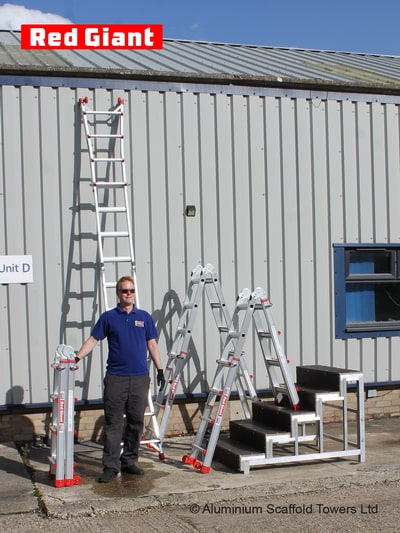No products in the basket.
Blog
Lightweight vs. Heavy-Duty Ladders: What’s Best for You?

When it comes to working at height, choosing the right ladder is just as important as the job itself. Whether you’re a UK homeowner doing DIY or a tradesperson working on-site, deciding between lightweight and heavy-duty ladders affects your safety, efficiency, and comfort.
This guide explains the main differences between both types, compares materials, and helps you find the ideal ladder for your home or trade use.
1️⃣ Understanding the Basics
Before comparing, let’s clarify the two main types:
🪶 Lightweight Ladders
Usually made from aluminium or fibreglass, designed for portability and quick set-up. Ideal for domestic and light trade use where you need to move or store your ladder frequently.
💪 Heavy-Duty Ladders
Built for strength, durability, and higher weight capacity, typically made from reinforced aluminium, fibreglass, or steel. Perfect for professional trades, construction, and industrial use.
2️⃣ Why the Choice Matters
Choosing the right ladder is not just about preference — it’s about safety and performance.
- ✅ Safety: The wrong ladder can cause accidents or equipment failure.
- ⚙️ Efficiency: A ladder that’s too heavy or awkward slows you down.
- 🧱 Durability: The right ladder withstands regular use and tough conditions.
- 💷 Cost-effectiveness: Investing properly prevents premature wear and replacement.
3️⃣ A Deep Dive into Ladder Materials Common in the UK
🪜 Aluminium Ladders — The All-Round Favourite
Pros:
- ✨ Lightweight — easy to carry and manoeuvre.
- 🌦️ Rust-resistant — ideal for the UK’s damp climate.
- 🛠️ Durable — long-lasting with minimal upkeep.
- 💰 Affordable — budget-friendly for most users.
Cons:
- ⚡ Conducts electricity — never use near live cables.
- 💨 Can move slightly in strong wind if unsecured.
Best for: DIY, decorating, window cleaning, guttering, loft access.
⚡ Fibreglass (GRP) Ladders — The Safe Choice for Trades
Pros:
- 🔌 Non-conductive — safe for electrical work.
- 🧱 Strong and robust — handles heavy loads.
- ☀️ Weather and chemical resistant — ideal for outdoor sites.
Cons:
- ⚖️ Heavier than aluminium.
- 💸 More expensive.
- 🌤️ Can become brittle with prolonged UV exposure.
Best for: Electricians, telecom engineers, and professionals needing non-conductive, heavy-duty ladders.
🏗️ Steel Ladders — The Industrial Heavyweight
Pros:
- 💪 Extremely strong — supports the highest loads.
- 🧍♂️ Very stable — feels solid when erected.
Cons:
- ⚖️ Very heavy — awkward to move alone.
- 🌧️ Prone to rust — needs maintenance.
- ⚡ Conducts electricity — unsafe for electrical work.
Best for: Warehouses, factories, or fixed installations where the ladder stays in place.
4️⃣ UK Safety Standards to Know
Always check your ladder complies with BS EN 131, the key European safety standard for portable ladders.
- 🏷️ EN 131 Professional: For trade and industrial use (max load ≈ 150 kg). These ladders are the most durable, having been designed to withstand more demanding conditions.
- 🏠 EN 131 Non-Professional: For domestic and household use (max load ≈ 150 kg). These ladders are intended for lighter, occasional use.
Tip: Always choose a ladder with a duty rating above your total working weight (you + tools + materials).
For tradespeople, EN 131 Professional certification is mandatory for safety and insurance compliance.
5️⃣ Lightweight vs. Heavy-Duty Ladders: Key Differences
| 🔍 Feature | 🪶 Lightweight Ladders | 💪 Heavy-Duty Ladders |
|---|---|---|
| Material | Aluminium / Fibreglass | Reinforced Aluminium / Fibreglass / Steel |
| Best For | DIY, light trade, mobility | Construction, trade, industrial work |
| Portability | Very portable | Less portable |
| Durability | Moderate | High |
| Cost | Lower | Higher |
| Safety Standard | EN 131 Non-Professional | EN 131 Professional |
6️⃣ When to Choose a Lightweight Ladder
Choose a lightweight ladder if you value ease of movement, compact storage, and quick access for light jobs.
- 🏡 Domestic DIY: Hanging curtains, painting, cleaning gutters.
- 🌳 Gardening: Trimming hedges or maintaining sheds.
- 🛠️ Light trade work: Electricians, decorators, or plumbers on short jobs.
- 🚗 Transport convenience: Telescopic or folding ladders fit easily in cars or vans.
Advantages:
- ✅ Easy to carry and store.
- ✅ Budget-friendly.
- ✅ Ideal for short, light-duty tasks.
- ✅ Widely available in multiple styles.
Limitations:
- ⚠️ Lower load capacity.
- ⚠️ Less suitable for prolonged or heavy use.
- ⚠️ May not meet professional safety requirements.
7️⃣ When to Choose a Heavy-Duty Ladder
If you’re a professional tradesperson, a heavy-duty ladder is usually the smarter, safer investment.
- 🏗️ Construction sites: Carrying tools and materials.
- 🧰 Professional trades: Roofers, builders, electricians.
- 🏢 Commercial maintenance: Cleaners, warehouse workers.
- ⚡ Specialist use: Non-conductive fibreglass ladders near electricity.
Advantages:
- ✅ Meets strict EN 131 Professional standards.
- ✅ More stable under heavy use.
- ✅ Built for long service life.
Limitations:
- ⚖️ Heavier and less mobile.
- 💷 Higher upfront cost.
- 🏠 Overkill for simple household use.
8️⃣ Key Questions Before You Buy
🧠 1. What will you use it for?
- • Quick indoor DIY → Lightweight aluminium step ladder.
- • Outdoor painting/gardening → Aluminium or fibreglass extension ladder.
- • Electrical work → Always fibreglass.
- • Trade work → Heavy-duty fibreglass or reinforced aluminium.
📅 2. How often will you use it?
- • Daily transport → Lightweight saves time and effort.
- • Occasional or fixed location → Heavy-duty ladder is fine.
🏡 3. Where will you store it?
- • Limited space → Telescopic or multi-purpose ladder.
- • Large garage/shed → Full-length extension ladder.
9️⃣ Safety First — Every Time
No matter what ladder you choose, safety comes first.
- ✅ Check for BS EN 131 certification.
- 🔍 Inspect before every use — look for cracks, loose rungs, or dents.
- 📐 Use the 1-in-4 rule (1 unit out for every 4 units up) for leaning ladders.
- 👣 Secure both top and bottom — use stabilisers or have someone foot it for leaning ladders.
- 🚫 Don’t overreach — keep your belt buckle within the stiles.
- 🧰 Consider stand-offs or platforms for gutter work.
🔟 Which Ladder Is Right for You?
- 🏠 For homeowners: Lightweight aluminium ladders offer practicality, affordability, and rust resistance.
- 👷 For professionals: Heavy-duty fibreglass or reinforced aluminium ladders provide unmatched strength and compliance.
- ⚖️ For mixed use: Fibreglass ladders strike a perfect balance — safe, strong, and reliable.
🏁 Conclusion
The debate between lightweight and heavy-duty ladders isn’t about which is better overall — it’s about what’s right for your job.
For DIY or occasional home use, go lightweight aluminium.
For trade or industrial work, choose heavy-duty fibreglass or reinforced aluminium.
Whichever you pick, make sure it’s certified, stable, and fit for purpose — because working safely at height always comes first.
Further reading:
Explore more ladders and towers at Aluminium Scaffold Towers UK.
Understand safety markings: Tower Safety Markings Explained.
Choosing Between Aluminium and Fibreglass Ladders: What You Need to Know








